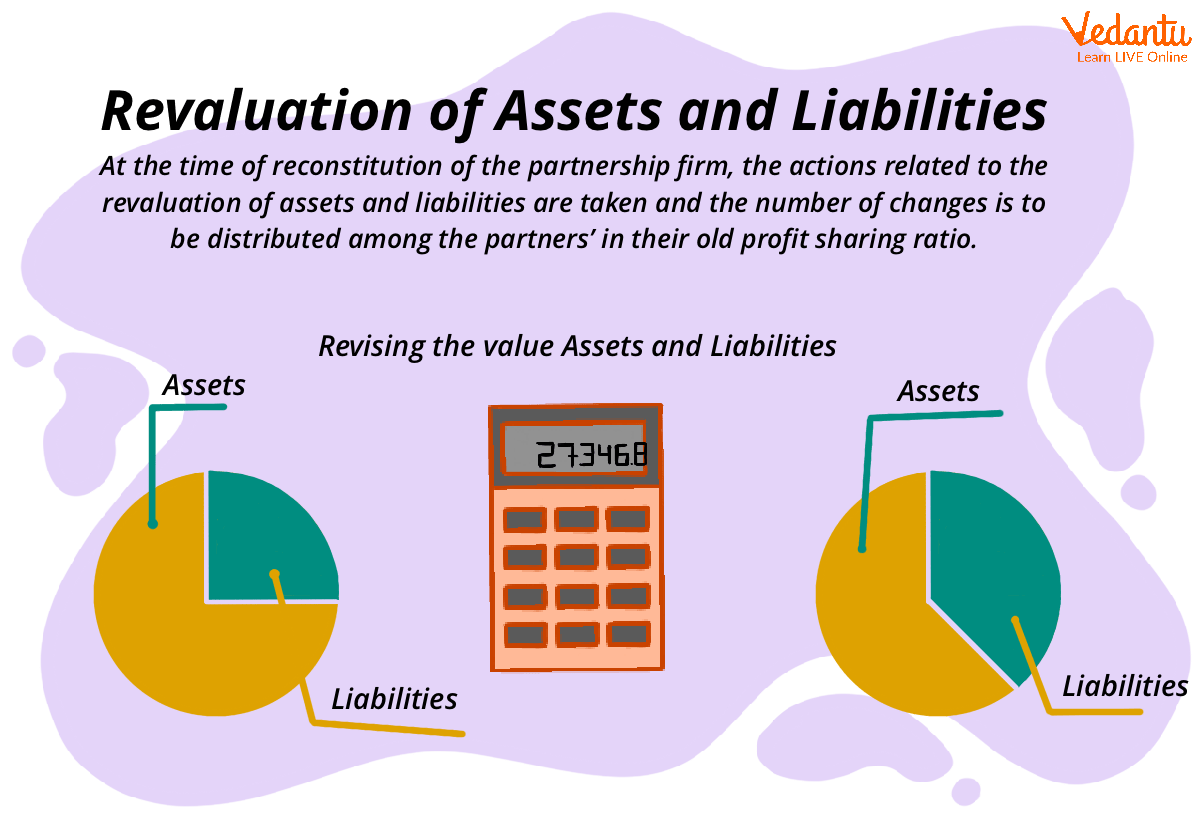




What is Assets Revaluation?

Revaluation of Assets and Liabilities
The term "revaluation of assets" refers to an increase or decrease in the market worth of holdings. When the book value of an asset is less than its current market value, an assessment is usually conducted.
According to the revaluation account meaning, the United States Generally Accepted Accounting Principles (GAAP) require that all fixed assets be recorded at historical costs. Additionally, revaluation of fixed assets accounting treatment at a lower price or fair market value.
Cost should account for the revaluation of fixed assets following International Financial Reporting Standards. Afterwards, businesses may choose between the Cost Model and the Revaluation Model. Inside the cost model, assets are depreciated during their useful lives without adjustments to the carrying value.
The tangible and immovable assets are re-evaluated. The cost of an investment in the fair value model may be changed, based on its fair value, either upwards or downwards. Reserve funds are put aside and given the official designation "Revaluation Reserve" when an asset's value is changed. The calculation of revaluation of assets was credited or debited as appropriate, depending on the direction of the change in asset value. The physical and intangible assets are reassessed in light of current market conditions.
Revaluation of Fixed Assets

Revaluation of Assets and Liabilities
When there is a significant increase or decrease in the fair market value of an asset, its carrying value must be re-evaluated. Under the IFRS framework, revaluation is permitted; however, it is not allowed under US GAAP.
Intangible fixed assets are accounted for using one of two models detailed in International Accounting Standard (IAS) 38 Intangible Assets. In contrast, tangible fixed assets are accounted for using the model described in IAS 16 Property, Plant, and Equipment.
The historical cost of a fixed asset is subtracted from its cumulative depreciation and accumulated impairment losses to determine its carrying value per the cost model. Therefore, the deal does not go higher due to the shifting conditions since there is no adjustment.
Revaluation Method of Depreciation
Fixed asset depreciation may be calculated quickly and easily using the revaluation approach. For determining the depreciation charge, the value of the asset being depreciated is determined at the beginning and end of the year, with any revaluation losses occurring throughout the year included. An internal expert or an independent consulting valuer is often responsible for the appraisal.
Depreciation is often calculated using the revaluation method of depreciation, which contains a depreciation formula for low-value, low-cost, and low-volume fixed assets aggregated for accounting purposes. Due to the complexity and time involved in computing depreciation for each purchase, this technique simplifies the process. Try searching for a revaluation account example for a better understanding.
Solved Example: Journal Entry of Upward Revaluation Reserve
1. According to Axe Ltd.'s latest market analysis, the structure is worth Rs. 200,000. As of the end of the first quarter of 2018, the balance sheet carrying value was Rs. 170,000. Represent the effect in the form of a journal entry.
The entry below represents an upward revaluation of assets, and its journal entry is as follows:
Building a/c Dr. 30,000
To Revaluation Reserve 30,000
Note that the rise in fixed assets' value is not shown in the income statement.
Conclusion
Whether or not to revalue the company's fixed assets is a vital accounting decision because it can significantly impact a number of the company's financial statements. Whether or not to revalue the company's fixed assets is a choice that must be made. Companies that use IFRS are required, as a result of this fact, to carry out the revaluation thoroughly and carefully, even though U.S. GAAP forbids them from doing so.
FAQs on Revaluation of Assets: Easy Steps to Calculate
1. What is meant by the revaluation of assets in accounting?
Revaluation of assets is the accounting process of adjusting the book value of a company's or firm's fixed assets to their current market value. This adjustment ensures that the balance sheet reflects a more accurate and fair value of the assets. It is most commonly performed during a significant event, such as the reconstitution of a partnership (due to admission, retirement, or death of a partner) or as per the revaluation model allowed under certain Accounting Standards.
2. What are the basic steps to calculate the profit or loss on revaluation of an asset?
To calculate the profit or loss from revaluing an asset, you can follow these simple steps:
Step 1: Identify the original book value (cost less accumulated depreciation) of the asset in the accounting records.
Step 2: Determine the new, current market value of the asset through an assessment by a qualified valuer.
Step 3: Compare the new market value with the book value. If the new value is higher, it results in a profit on revaluation. If it is lower, it results in a loss on revaluation. This profit or loss is recorded in the Revaluation Account.
3. What are the journal entries passed for the revaluation of assets?
The journal entries for revaluing assets depend on whether their value has increased or decreased:
For an increase in asset value (a gain): The Asset account is debited, and the Revaluation Account is credited.
Entry: Asset A/c Dr. To Revaluation A/cFor a decrease in asset value (a loss): The Revaluation Account is debited, and the Asset account is credited.
Entry: Revaluation A/c Dr. To Asset A/c
4. Why is it necessary to revalue assets and liabilities when a partnership firm is reconstituted?
The primary reason for revaluing assets and liabilities during the reconstitution of a partnership firm (like on the admission or retirement of a partner) is to ensure fairness. Over time, the market value of assets can change significantly from their book value. Revaluation ensures that any gain or loss arising from these changes is distributed among the old partners in their old profit-sharing ratio. This prevents an incoming partner from benefiting from past appreciation and protects a retiring partner from bearing the cost of a future decline in value.
5. What is the accounting treatment for the final balance (profit or loss) in the Revaluation Account?
After all adjustments for assets and liabilities are made, the final balance in the Revaluation Account represents the net profit or loss. This balance is not carried forward but is transferred to the Old Partners' Capital or Current Accounts. It is distributed in their old profit-sharing ratio. A profit on revaluation increases the partners' capital, while a loss decreases it.
6. Does revaluation only apply to assets, or are liabilities also included in the process?
The process is comprehensive and includes both assets and liabilities. The correct term is 'Revaluation of Assets and Reassessment of Liabilities'. Just as assets are revalued to their current worth, liabilities are reassessed to reflect their true obligation. For instance, an unrecorded liability must be accounted for (a loss), or the value of a liability like 'Provision for Doubtful Debts' may be adjusted (a gain or loss). This ensures the firm's overall financial position is accurately presented.
7. How is the revaluation of assets during a partnership change different from the revaluation method of depreciation?
These are two distinct concepts. The revaluation of assets for partnership reconstitution is a one-time adjustment to align asset values with their market price at a specific event. In contrast, the revaluation method of depreciation is a technique to calculate the annual depreciation charge for certain assets (like loose tools) by comparing their opening and closing values for an accounting period. The former adjusts capital accounts, while the latter is an operational expense.
8. Can you give an example of how revaluation of assets works in practice?
Certainly. Imagine a partnership owns a building with a book value of ₹5,00,000. Upon the admission of a new partner, the building is revalued and found to be worth ₹8,00,000. This is an increase of ₹3,00,000. This amount is a profit on revaluation. The journal entry would be:
Building A/c Dr. ₹3,00,000
To Revaluation A/c ₹3,00,000.
This ₹3,00,000 profit in the Revaluation Account will then be transferred to the old partners' capital accounts in their old profit-sharing ratio.





















